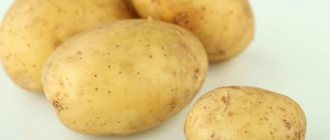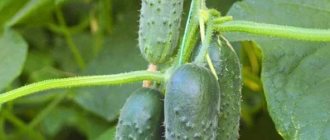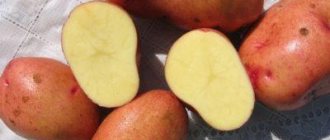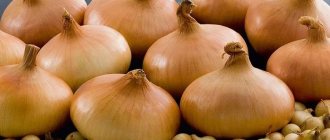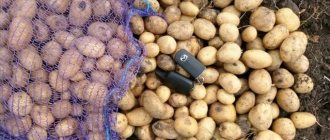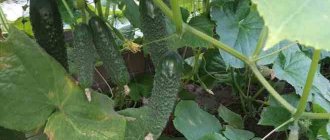Description and characteristics
Alena is an early ripening variety - from the emergence of seedlings to the harvesting of potatoes, it takes 45-60 days. This variety has the following individual parameters: bush - low, spreading; leaves are dark green with a slightly wavy edge; flowers - pink with a purple tint, collected at the top of the shoot; stem - “bare”, ribbed, partially buried in the soil; tubers - oval, weighing 150-200 g; the peel of root vegetables is smooth, thin, pink-red; The pulp of the vegetable is white with a creamy tint. The Alena variety appeared thanks to breeders of the Siberian Research Institute of Agriculture (Omsk Agricultural Research Center). The varieties Sedov, Kameraz and Zarevo were used for selection. The resulting potato variety was patented in the State Register of Seed Products of the Russian Federation in 2000.
Taste qualities
The vegetable has excellent taste characteristics, which are determined by the presence of appropriate chemical compounds and their concentration. The list of substances that determine the taste of potatoes is quite large.
The main ones are: water - 75%; starch - 17%; nitrogenous substances (crude protein) - 2%; sugar - 1.5%; fiber - 1%. Thanks to such a successful set of useful components and the presence of a given amount of starch, the variety is moderately boiled (medium-crumbly) and is widely used in cooking: it is boiled, stewed, baked, fried, and used in both simple and gourmet dishes. The variety is especially suitable for the industrial production of chips.
Did you know? In ancient times, in the Solomon Islands, potatoes were used as the equivalent of money - a visit to the doctor cost one potato.
Ripening period
The period of complete vegetative ripening of a vegetable depends on the region of growth and weather conditions. This variety tolerates both arid and colder climates. Harvest ripening time is, on average, from 45 to 65 days.
Productivity
To obtain early products, tubers are collected on days 45–50 of the growing season; the yield is 150 c/ha. Marketable yield, after the vegetable has fully ripened (60–65 days), is about 172–290 c/ha. The maximum yield of the variety in the Omsk region is 391 c/ha, which is Alena’s record.
Disease resistance
The described potato plant has average resistance to infectious and viral diseases. Alena has good resistance to diseases such as common scab, rhizoctonia, potato cancer. Susceptible to late blight, golden cyst nematode.
Did you know? Early potatoes contain 3 times more vitamins and nutrients than other, later varieties of this vegetable.
Alena's tuber crops are an example of a product with a set of undeniably positive qualities. Unfortunately, there are some negative aspects inherent to this vegetable. Let's take a closer look at the features.
Advantages and disadvantages of the variety
The plant stands out among other potato species by having a large supply of positive characteristics.
- The benefits are as follows:
- high, stable yield;
- early, friendly ripening of tubers;
- excellent adaptation to growing conditions;
- good drought resistance;
- excellent taste;
- long-term storage (7-8 months);
- excellent presentation;
- suitability for mechanized cultivation technology.
- Unfortunately, there is also a negative point:
- susceptibility to late blight and golden nematode.
Like any other garden crop, potatoes need the correct, competent application of agrotechnical measures.
Planting and growing varieties
The technology for growing early potatoes is not complicated and does not require any special costs or effort. But in order to get a tasty and healthy harvest, you need to show attention and proper care to the plant.
Deadlines
The time for planting seed material depends on the area where the plant grows:
- in the southern regions - the first ten days of April;
- in the western and eastern territories - late April - early May;
- for the northern regions - the second half of the May period.
The soil, by this time, should warm up to +4...+8°C. It is important to note that potatoes do not tolerate frost. When the ambient temperature drops to -0.5°C and below, the above-ground part of the plant dies. Newly regrown shoots form a weak, underdeveloped plant - the yield is reduced by almost half.
Crop rotation rules
The use of rational crop rotation is the key to obtaining good results when growing potato products. Constant cultivation of vegetables in one place leads to depletion of the soil and the accumulation of various infections and viruses in it. Therefore, the planting location needs to be constantly changed.
The following are considered good predecessors for potatoes:
- legumes (peas, beans);
- roots;
- cabbage;
- cucumbers;
- garlic;
- melon plants.
You cannot plant vegetables in beds where they previously grew:
- corn;
- sunflower;
- tomatoes and other representatives of the nightshade family.
A good result for maintaining soil fertility is obtained by sowing green manure in areas after harvesting: mustard, alfalfa, vetch. This helps not only improve the soil structure, but also helps in the fight against certain pests (wireworms, nematodes).
Soil requirements
The place for planting is chosen to be bright and sunny, with a low level of groundwater. Potatoes grow well on chernozem, slightly acidic, peat soils; loamy or sandy soils. Heavy, clayey, and sandy soil is not suitable for growing crops. Potatoes form tubers well if the soil is loose, moist enough, has good air access and water permeability.
Preparing tubers for planting
Potatoes for planting in the ground are sorted: damaged ones are discarded, leaving the strongest and healthiest, of the same size (slightly larger than a chicken egg). A month before the intended planting, potato tubers begin to germinate. This event makes it possible to obtain an early harvest in a shorter time.
There are several variations of this method.
- In the light. Boxes with prepared seed potatoes are placed in a bright place without direct sunlight. Germination lasts 25–30 days. In the absence of natural light, use backlighting – fluorescent lamps.
- In a moist substrate. Place the tubers in damp sawdust or peat, making sure that the substrate does not dry out. Sprouts appear after 18–20 days.
- Drying. The easiest way to prepare seeds. The prepared tubers are laid out on the floor of the room (attic, barn, garage). Shoots form within 2 weeks.
- In packages. Transparent plastic bags with tubers are placed in areas of diffused sunlight. They must be periodically unfolded and turned over for uniform illumination. The weight of the package should be 1.5–2 kg. The shoots grow in 15–18 days.
In all cases of the event, the germination temperature must be maintained within +14…+16°C.
Landing technology
Before planting potatoes, a preliminary marking of the area is carried out. Usually pegs and threads are used for this. The depth of the holes is determined by the condition of the soil. The heavier the soil, the less deep the holes are: for sandy loam and peat soils - 8-10 cm, for loamy soils - 5-6 cm. Planting vegetables in the ground can be done in several ways.
- Rows (under the shovel). Early vegetables are planted at a distance of 25 cm from each other, the distance between rows is 0.7 m. The planted potatoes are sprinkled with soil from the hole in the next row. It is advisable to immediately apply fertilizer to each hole: half a glass of wood ash with humus or one teaspoon of nitroamophoska. At the end of planting, the ground on the site is leveled with a rake.
- Into the ridges. Using a shovel or walk-behind tractor, make continuous furrows 15 cm deep. On the surface of the top of the ridge, holes are made at a distance of 25 cm, where the tubers are placed. Cover with soil from adjacent rows. The gap between the ridges is 70 cm.
- In the trench. This planting method is more often used for regions with cold climates. “Warm” beds are prepared in the fall. Organic matter is placed in the furrows made to a depth of 30 cm. In the spring, after the fertilizer has been deposited, potatoes are planted in trenches and covered with soil. The planting pattern is the same as in the previous versions.
- In double rows. Two adjacent rows are spaced at a distance of 0.3 m with a row spacing of 1.1 m.
- Tuber crops are planted in checkerboard pattern, with an interval of 35 cm. Hill up in one row.
It should be noted that the best way to plant potatoes is a method that has been proven in practice. This variety is unpretentious when grown, but still requires a correct and timely approach to performing agrotechnical manipulations.
Video about the variety “Alena”
Unfortunately, there is no video for this variety at the moment. We invite you to watch the video section of our website, where other videos about potatoes and other agricultural crops are posted. We and the entire farming community will be grateful if you send us your video or link about this variety from YouTube or any other video hosting service. If you see this message, it means that we have not yet been able to find a suitable video for this variety.
Similar articles:
Potatoes and all their varieties in detail here → Potato variety “Bryansk New” - description characteristics reviews photos video
Potatoes and all their varieties in detail here → Potato variety “Bellarose” - description characteristics reviews photos video
Potatoes and all their varieties in detail here → Potato variety “Borus” - description characteristics reviews photos video
Potatoes and all their varieties in detail here → Potato variety “Bonnie” - description characteristics reviews photos video
Potatoes and all their varieties in detail here → Potato variety “Bashkir” - description characteristics reviews photos video
Features of care
After the emergence of seedlings, it is necessary to carry out a number of measures aimed at comfortable and rapid growth of plants in order to obtain high yields.
Fertilizer
Proper and timely fertilizing of crops is one of the best ways to increase crop productivity.
Important! For better absorption of nutrients, it is recommended to apply root (under the root) fertilizers only to pre-moistened soil.
This work is carried out in several stages:
- after germination - dilute 1 kg of chicken manure in 15 liters of water (leave for 48 hours), pour a liter of the resulting solution under the root;
- before hilling - 1 tbsp. a spoonful of urea is dissolved in 10 liters of water, 0.5 liters of the substance are added under the bush;
- during the budding period - stir 3 tbsp in ten liters of water. spoons of superphosphate and irrigate the bushes;
- during flowering - per bucket of water: 100 g of superphosphate, 0.5 kg of mullein. Mix and add 0.5 liters of the resulting substance to each plant.
Video: growing potatoes (when and what to feed)
Watering
Potatoes Alena tolerate hot weather well, but will still respond gratefully to generous watering. Sufficient soil moisture will help tuber crops to fully increase their green mass and form a larger number of “children”. Lack of moisture will lead to depletion of the plant, reducing its potential.
Therefore, it is advisable, in the absence of precipitation, to water the plantings twice a week:
- after emergence - for normal development of the above-ground part;
- during flowering - when tubers form, their number increases;
- after flowering is completed - in order to activate the mass gain of tuber crops.
Watering is carried out in the evening, after the heat has subsided, using a large volume of water. The soil layer must be moistened to a depth of at least 10 cm to properly nourish the plant.
Weeding and hilling
A week after planting, the first weeding is carried out between the rows, and then, as the weeds grow, every 7 days. Sprinkling the plant stems with damp soil and loosening occurs simultaneously. Hilling is carried out 2 times during the growing season. The first sprinkling of soil is done when the sprouts reach a height of 8–10 cm, and after two weeks the procedure is repeated. At each event, soil 5–12 cm high is poured onto each bush.
Hilling potatoes provides the following advantages:
- increases productivity by 25-30%;
- reduces lodging of stems;
- increases the formation of additional nodules;
- promotes good air circulation in the underground part of the plant;
- retains moisture and nutrients;
- prevents the appearance of “green” potatoes.
Important! It is impossible to carry out hilling during the flowering of plants, since during this period there is increased growth of the underground part of the nightshade crop, and there is a risk of damage.
Prevention from diseases and pests of the variety
Potato plants are susceptible to some viral and infectious diseases and suffer from pests. It is necessary to take timely and preventive measures to prevent the death of the plant and fully preserve the future harvest.
Alena is susceptible to some negative phenomena.
- Late blight. One of the most common fungal diseases of a crop that affects the entire plant. Dark brown spots that appear first on the leaves gradually spread to the tubers. Used for treatment and prevention: copper sulfate, Bordeaux mixture, drugs "Ridomil", "Agate", "Shirpan".
- Common scab. A fungal disease that most often affects red-skinned tubers. Small ulcers and scabs form on the fruits, which grow over time. To combat the disease, “Prestige”, “Ditan”, “Acrobat MC”, “Ordan” are used.
Various pests also annoy potatoes, causing damage to the future harvest.
Let's look at the most dangerous of them.
- Colorado beetle. This insect is one of the most dangerous potato pests. If measures are not taken to destroy it, the entire crop is likely to die. In the fight against the parasite, the following insecticides are used: Aktara, Bombardier, Komandor, Iskra Zolotaya, etc.
- Golden nematode. A small parasitic worm (up to 1 mm long) that lives on the plant and infects it entirely. Nematicide drugs, as well as Nemabakt and Karbofos, are well suited for combating the parasite.
- Medvedka. A malicious pest that lives in the ground and eats not only the plants themselves, but also the tubers. Insectoacaricides that are effective in the fight against insects are “Terradox”, “Vofatox”, “Medvetsid”, and the biological product “Rembek”.
Planting plants with a spicy aroma in the spaces between potato rows is good for repelling harmful insects.
Marigolds, matiola, nasturtium, mint, sage, and calendula are used for plantings. It is effective to use coniferous and alder branches located in small piles around the site. By taking preventive measures to protect potatoes from various ailments and parasitic insects, you can reduce their spread in your garden plot and even get rid of them. For these purposes, it is necessary to carry out the following operations:
- follow the rules of crop rotation;
- disinfect planting material, agricultural equipment and storage areas for vegetable products;
- remove diseased plants from the beds;
- use chemicals and folk remedies to protect plants in a timely manner.
When using chemicals, be sure to follow the instructions for their use. It is also important to properly organize the harvesting of potatoes and ensure their comfortable storage in the winter.
Potato Alena: variety description, photos, reviews
FermoVed.ru » Vegetable growing » Potatoes » Description of potatoes Alena
0
844
Article rating
Alena potatoes have gained great recognition in the world market due to the fact that they can produce a good harvest, even in areas with short summers and unfavorable soil. The development of bushes occurs at a decent speed, literally in a month and a half. During this time, the fruits fully ripen and accumulate the required amount of necessary elements.
Description of Alena's potatoes
Characteristics of the variety
Alena was bred in Holland at the end of the last century. Literally a few years later it was included in the national register. It is believed that it is best to grow it in northern countries, where climatic conditions are always cold.
It is recommended to grow it not only on agricultural land, but for personal use. Quite often it is grown in industrial enterprises. This is due to the fact that these potatoes tolerate long-term storage well and can be transported over long distances. Due to the fact that its tubers have an ideal, even shape, it makes excellent semi-finished products. Also, it is very often grown for sale.
The description and characteristics of the plant deserve attention. Alena ripens faster than other early varieties. Its tubers form and ripen in a month and a half. It is believed that full ripening occurs 50 days after planting. Productivity is high. From 1 hectare of vegetable garden it is possible to collect up to 300 kg of finished products.
It is believed that the harvest will be at a high level if the soil is rich in useful microelements. Also, if you properly care for this species and feed the soil on time, you can increase the amount of harvest by 2-2.5 times. If you plant seed material in June, then in July you can already dig a small amount of potatoes for your own consumption. But mass cleaning should be carried out in August.
Appearance
The bush does not grow tall. Its tops can spread, but not over long distances. The leaves on the tops are small in size and have minimal waviness at the edges. The corollas are presented from a small number of white flowers.
The root system is striking in its development. You can collect up to 20 root vegetables from one bush. Due to the small quantity of non-commercial products, it sells quickly. The variety is not susceptible to diseases, so you don’t have to worry about diseases and pests. Alena potatoes do not degenerate, so you can collect seed material yourself from the previous harvest.
Description of the fruit
Ripe tubers are quite large. The weight of each tuber can reach 150-200 g. The shape resembles an oval, and is always smooth, without flaws. You can find fruits that will have an oblong shape. All tubers have the same weight and their shape is similar to each other, which is why they are so ideal for sale.
The peel is presented in light yellow tones, and is very thin in structure. Its color is uniform throughout the potato. You can see eyes, but they are very small, almost invisible. If you cut the fruit, you can see that the flesh has a cream or yellow tint. The amount of starch is not bad, and is about 14%. Alena contains a large amount of vitamins, minerals, and protein, so it can be used not only for making purees or soups. This is ideal for baking or making French fries.
Advantages of the variety
Tasty and productive potatoes
The most important advantages of this potato variety are considered to be:
- the description speaks of the unique taste of potatoes;
- high level of productivity;
- characterized by high storage rates and does not deteriorate during long-term transportation;
- can be used to prepare any dishes;
- not picky about the soil for planting seeds;
- tolerates drought well;
- if you pay attention to the description, this variety is not susceptible to diseases and pests;
- tolerates adverse weather conditions well.
There is no shortage of this variety. But, in order to get a good harvest, it is necessary to regulate watering, feed the soil well and loosen the soil.
Growing rules
For planting in the ground, you should choose only those fruits that have a beautiful appearance, are free from diseases, and they should be small in size. In order to prevent diseases and accelerate the growth of seedlings, it is necessary to treat the seeds with Fitosporin. Also, to improve productivity indicators, it is necessary to fertilize the soil with both mineral and organic fertilizers. But it is best to alternate these two feedings.
In order not to risk the harvest due to insufficient moisture, it is better to install drip irrigation. This will allow you to regulate the water balance of the soil and prevent the potatoes from forming incorrectly. Also, such potatoes do not require special care. Before planting, it is necessary to treat each potato with special chemicals that will protect it from negative effects.
It is also necessary to put humus in each hole. Between the bushes you need to maintain a distance of 30 cm. But between the rows you need to maintain a distance of 80 cm. During this month and a half, you should hill up the potatoes several times, and do not forget to remove all weeds from the soil. To increase the amount of future harvest, you can put straw or dry grass between the rows.
Before harvesting, a few weeks before, it is necessary to feed all the bushes with special phosphates. This will allow the tubers to absorb all the necessary substances from the tops and ripen faster. Before you start harvesting, you need to remove all the tops. After digging up the tubers, you need to hold them in the sun for a while to dry them better, and only then move them to storage areas.
Disease Prevention
The description says that this potato variety quite easily resists all negative diseases and pests. It is not affected by cancer, nematodes and other common viruses and fungal infections. Also, due to its rapid ripening, it is not susceptible to late blight.
POTATO VARIETIES NEED TO BE CHOOSE CORRECTLY!
24. Potatoes Choosing potato varieties
As a preventative measure, you can spray all the bushes with special preparations that contain copper. Also, do not forget that all seed material must be treated with chemicals that are toxic to pests.
Quite often, insecticides are used that can protect potatoes from pests. They should be placed under each bush in the soil, and all furrows should be sprayed superficially. These chemicals will help protect against not only moths or aphids. This remedy will help prevent the appearance of the Colorado potato beetle. Also, as a preventive measure, you can use wood ash, which must be placed in the holes before planting.
fermoved.ru
Harvest and storage
You can determine that the potatoes are ripe by the autumn withering of the above-ground parts. 2 days before the expected collection of the product, the tops are mowed or cut off. Tubers are harvested in dry, clear weather. Use a pitchfork or shovel to carefully dig up the bush from the ridge side, shake off the soil and leave the tubers to dry for 2–3 hours. Before storing the vegetables, they are sorted, removing damaged and diseased specimens. Place the crop in a dry, well-ventilated room with a temperature of +2...+4°C and a relative humidity of 80% - 90%.
Vegetables can be stored using one of the options:
- in boxes - tubers are placed in containers that are placed on pallets or boards (distance from the floor - at least 10 cm);
- in bulk - the layer of potatoes should not exceed 1.5 m;
- in nets, fabric bags - in stacks, no more than 1.5 m high.
Seed material should be stored separately from the general purpose product.
During the winter period, it is necessary to regularly inspect the tubers, removing rotten and diseased ones. If all recommendations are followed, the shelf life of this product will be 95%. Alena potatoes are unpretentious when cultivated - they do not require special costs or effort. With such small shortcomings that are lost against the backdrop of a huge number of positive criteria, this variety of nightshade plant is undoubtedly worthy of taking pride of place in your garden bed. By following the necessary recommendations for agricultural cultivation techniques, taking care and proper care of the plant, you will certainly get the expected result: a high, excellent harvest of your favorite vegetable.
How to harvest
The ripening of potatoes is signaled by yellowed tops. If this happens, it means it's time to harvest. As a rule, the tops fall off in August or September, depending on the planting time. Before harvesting potatoes, the tops need to be mowed 10-15 days before digging begins.
The work order is as follows:
- The tubers are dug up with a shovel or passed between the rows with a walk-behind tractor.
- After this, they should lie in the sun for two to three hours to dry in order to avoid rotting. It is desirable that the weather be dry.
- The final stage will be collecting root crops in bags or nets.
- The containers are moved to storage areas.

